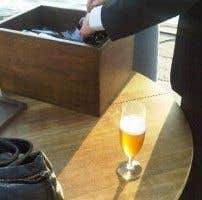This article was also published in the Financial Times.
At 11.30 pm, Mads Kleppe, the Norwegian sommelier at Noma, Copenhagen, currently the world's most talked about restaurant, clinked one of the many empty wine bottles he had expertly served and eventually silenced our party of 14 in their private dining room. Before dessert, he wanted to take us on a kitchen tour.
But as with so much at Noma, what we subsequently experienced was deeply unusual. The initial kitchen we walked through was relatively quiet but in the spacious second room, once used for events but due to house their R & D kitchen next year, half a dozen chefs were still hard at work.
Three were standing around a table cracking and nibbing beech nuts, part of a dish we had been served with four different varieties of old Scandinavian grains and a watercress emulsion.
In the corner, facing a computer and surrounded by paper, was Victor Wågmann, a Swedish chef in charge of dealing with produce and Noma's unpredictable working relationship with over 50 different suppliers. He was deep in conversation with sous-chef Sam Miller, from Nottingham, England, who has already worked at several top restaurants across Europe. They were earnestly discussing the recent hot weather, and the impact it would have on their suppliers and therefore future menus.
In front of us stood an American, Matt Orlando, executive head chef and second in command to René Redzepi, who had opened Noma in 2003. When Orlando had been explaining the fourth course of our eleven-course dinner – carrots that had been left in the ground over the winter so that the sugar content breaks down to concentrate the flavour, then roasted and served with sorrel and a sauce from Swedish black truffles – he had also explained his peripatetic career path.
'Six years ago I was working for Heston Blumenthal at The Fat Duck in Bray, England, and my room-mate was Danish. Redzepi came to see Heston and we all went out for a drink afterwards. That's what brought me here the first time. Then Thomas Keller persuaded me to go to New York as senior sous-chef at Per Se before I came back here. I am now married to a Dane so I don't think I'll be leaving.'
What distinguishes Noma from any of the world's leading restaurants I have been lucky enough to eat in is not just its location, right by the water's edge, but also that it occupies the ground and first floor of a distinguished 18th-century warehouse built for the processing of salt, cod and whale meat that were then such important commodities. The former pub that is home to today's Fat Duck is older but does not have such views.
By this stage I had learnt that Noma employs 65 and serves no more than 70 customers a day plus the private room it opens two to three nights a week, so I knew that profitability would be slim. But I immediately reached for my notebook when Orlando confided to us that last year Noma recorded a profit of just 80,000 Danish Krone, or £10,000, having paid off their far-sighted investors.
Money is not what drives these chefs, certainly not the many interns or stagiaires that apply to Noma every day for work experience. Handling these is also part of Orlando's duties (there are currently 22 in his in-tray) and while he is full of admiration for anyone prepared to work for nothing in a city as expensive as Copenhagen, he makes sure that none leaves without experiencing their distinctive foraging trips.
These trips – to land owned by farmers that they know, public beaches, the area surrounding one particular castle, and another close to several lakes – always involve a chef and several stagiaires, who will leave not just with a knowledge of what Denmark has to offer but also what invariably lies neglected under their noses back home. Orlando continued, 'The last time I went back to California I went hiking in the hills around San Diego and I couldn't believe the abundance of herbs and flowers that I hadn't previously been paying any attention to.'
These wild ingredients appeared throughout our meal together with something more mundane, the most moreish warm bread served with goats' milk butter, which any baker anywhere would have been proud of. As with any animated, food-obsessed group, there were quibbles, most notably about the absence of protein in all but two dishes, but most were remarkable.
Most impressive in my opinion was a combination of a cold razor clam, buttermilk and horseradish; the finest slices of last season's chestnuts arranged vertically in a bowl with cress and diced walnuts underneath; the sight of 14 chefs walking into the room each carrying a heavy, smooth rock on which was splayed a grilled langoustine with a dipping sauce; and a dish of six different vegetables each pickled in a different brine, served with wild flowers and a pork sauce. This was served by a French waiter, who confessed, 'You would never see a dish like this in a restaurant in France. That's why I'm here.'
Those who work at Noma are encouraged to engage fully with customers and did seem more like members of a sect than anything else, so attuned are they to the credo and principles of the restaurant, as though they were under what could be described as 'the Noma coma'.
But in spreading his culinary principles so widely, in teaching so many to look at the wild ingredients Nature makes available so regularly but we have ignored for so long, Redzepi is doing us all a great favour. Noma could exist only in Copenhagen but those who have passed through its kitchens may soon bring its principles to a restaurant near you.
www.noma.dk

